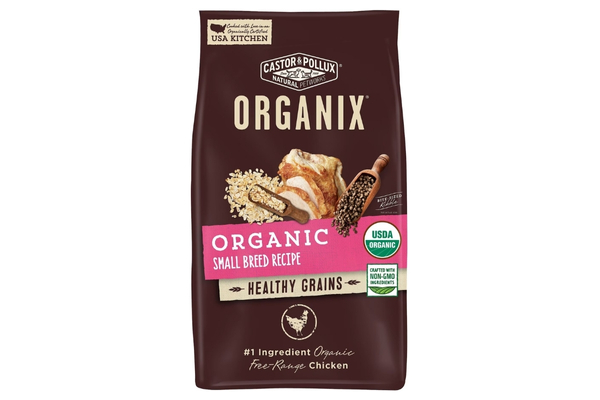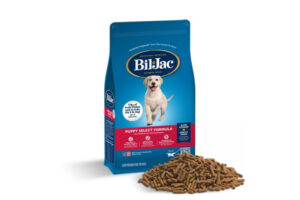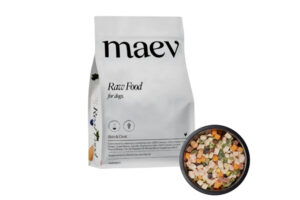Castor & Pollux has carved out a distinctive place in the premium dog food market by focusing on what many pet owners increasingly want: organic ingredients, transparent sourcing, and quality nutrition. Founded in 2000 in Oregon, this brand made history by creating the first USDA-certified organic dog food, setting a standard that many others would follow. While the company has changed hands over the years—first acquired by Merrick in 2012, then becoming part of Nestlé Purina’s portfolio—it’s maintained its commitment to natural, high-quality ingredients and organic certification.
What sets Castor & Pollux apart isn’t just marketing speak about premium ingredients. Their ORGANIX line genuinely delivers on organic promises, with USDA certification that requires rigorous oversight of everything from ingredient sourcing to manufacturing processes. This isn’t a small detail—organic certification means no synthetic pesticides, herbicides, or artificial preservatives, which appeals to dog owners who scrutinize labels as carefully for their pets as they do for themselves.
What Does the Brand Stand For?
Core Values and Mission
Castor & Pollux built its reputation on a simple but powerful premise: dogs deserve the same quality ingredients that health-conscious humans seek for themselves. The brand’s commitment to organic certification isn’t just a marketing angle—it represents a fundamental philosophy about ingredient integrity and manufacturing standards. When they became the first pet food company to achieve USDA organic certification, they weren’t just breaking new ground; they were establishing credibility in a market often filled with vague “natural” claims.
The company’s approach reflects a broader shift in pet ownership attitudes. More owners now view their dogs as family members deserving premium nutrition, not just whatever’s cheapest at the grocery store. This positioning has allowed Castor & Pollux to compete successfully in the super-premium segment where quality matters more than price.
Market Position and Reputation
Under corporate ownership, the brand has maintained its independent identity while gaining access to broader distribution networks and manufacturing resources. The backing of Nestlé Purina provides stability and resources that many smaller organic brands lack, while the commitment to preserve the brand’s specialized focus suggests recognition of what makes it successful.
Industry professionals generally regard Castor & Pollux favorably, with products regularly earning high ratings from pet food review platforms. The brand’s safety record is notably clean compared to many competitors, with limited recall incidents and no major contamination issues affecting core product lines.
Ingredient Analysis
Primary Protein Sources
The ingredient lists across Castor & Pollux products consistently prioritize named animal proteins as first ingredients. In their ORGANIX Grain-Free line, you’ll typically see fresh chicken leading the ingredient panel, followed by chicken meal as a concentrated protein source. This combination makes sense nutritionally—fresh chicken provides palatability and some protein, while chicken meal delivers the concentrated protein content that remains after moisture removal.
What I find impressive about their protein sourcing is the consistency across product lines. Whether you’re looking at their Natural Ultramix or PRISTINE lines, the focus remains on identifiable animal proteins rather than vague “meat meals” or by-products. The organic lines take this further by requiring that these proteins come from animals raised without antibiotics or growth hormones.
Carbohydrate Sources and Grain-Free Approach
The brand’s commitment to grain-free formulations means they rely heavily on sweet potatoes, regular potatoes, and peas as primary carbohydrate sources. Sweet potatoes bring more to the table than just carbs—they provide fiber, beta-carotene, and various vitamins that support overall health. The inclusion of peas adds both carbohydrates and plant-based protein, though this does mean some of the impressive protein percentages on guaranteed analysis panels come from plant sources rather than meat.
Tapioca appears in many formulations as a gluten-free binding agent. While it doesn’t add much nutritionally beyond digestible carbohydrates, it serves an important functional purpose in kibble production and maintains the grain-free status that appeals to many consumers.
Controversial and Noteworthy Ingredients
One ingredient that raises eyebrows is garlic, which appears in some Castor & Pollux formulations. While some holistic practitioners advocate for garlic’s potential health benefits, it’s worth noting that garlic can cause Heinz body anemia in dogs when consumed in significant quantities. The amounts used in commercial dog food are typically well below toxic levels, but it’s still an ingredient that makes some veterinarians and pet owners uncomfortable.
The brand uses mixed tocopherols (vitamin E) for natural preservation instead of synthetic preservatives like BHA or BHT. This aligns with their natural positioning and provides effective preservation without the concerns some owners have about artificial additives.
Nutritional Value and Composition
Macronutrient Profiles
The nutritional density of Castor & Pollux products consistently exceeds average commercial dog food standards. Their ORGANIX Grain-Free line delivers approximately 29% protein and 17% fat on a dry matter basis, with estimated carbohydrate content around 46%. These numbers represent above-average protein and fat levels that support active dogs and those requiring higher nutritional density.
What’s particularly notable is the fat-to-protein ratio, which sits around 58% across most dry formulations. This balanced approach provides adequate energy density without excessive fat levels that might concern owners of less active dogs or those prone to weight gain.
AAFCO Compliance and Standards
All major Castor & Pollux product lines meet AAFCO nutritional adequacy standards for adult maintenance, providing assurance that dogs can thrive on these foods as their sole diet. The brand’s attention to calcium-phosphorus ratios and essential fatty acid profiles demonstrates understanding of canine nutritional requirements beyond just hitting minimum protein and fat targets.
The inclusion of chelated minerals in many formulations shows attention to bioavailability—these minerals are bound to proteins for enhanced absorption compared to basic mineral salts used in lower-quality foods.
Suitability for Different Dogs
Best Candidates
Castor & Pollux products work particularly well for adult dogs with normal activity levels whose owners prioritize ingredient quality and organic certification. The grain-free formulations appeal to dogs with suspected grain sensitivities, though true grain allergies are relatively uncommon in dogs.
Small breed formulations address the unique needs of smaller dogs through appropriate kibble sizing and adjusted nutritional profiles. The higher metabolic rates of small dogs often require more calorie-dense foods, which these formulations provide.
Dogs with skin and coat issues often benefit from the omega fatty acids provided by ingredients like flaxseed, though owners should expect to wait several weeks to see visible improvements as the coat cycle takes time to reflect nutritional changes.
Dogs That Might Need Different Options
The relatively high fat content in some formulations may not suit dogs requiring low-fat diets due to pancreatitis or other digestive sensitivities. Similarly, the premium pricing makes these foods challenging for owners feeding multiple large dogs or those on tight budgets.
Puppies can eat many Castor & Pollux formulations, but owners should verify that specific products carry “All Life Stages” AAFCO approval rather than just adult maintenance approval.
Taste and Acceptance
Palatability Factors
The emphasis on real meat ingredients and natural fats typically translates to good palatability for most dogs. The inclusion of chicken fat and other natural flavor enhancers helps make these foods appealing without relying on artificial flavor sprays common in lower-quality kibbles.
The variety of protein sources across product lines—chicken, turkey, beef, lamb, salmon, and duck—provides options for dogs with specific preferences or owners who like to rotate proteins. This variety also helps if you discover your dog has sensitivities to particular proteins.
Transition Considerations
Like any premium food, Castor & Pollux products may require a gradual transition period, especially for dogs moving from lower-quality commercial foods. The richer ingredient profile and higher fat content can sometimes cause temporary digestive upset if introduced too quickly.
Price-Quality Analysis
Cost Breakdown
Daily feeding costs for Castor & Pollux range from approximately $2-4 for small dogs to $5-9 for large breeds, depending on the specific product line and package size purchased. These costs place the brand firmly in the premium category, requiring significant budget commitment from pet owners.
The organic certification and high-quality ingredients justify much of this premium, but it’s worth comparing what you’re getting. When you consider that organic chicken costs significantly more than conventional chicken even for human consumption, the pricing becomes more understandable, though still substantial.
Value Proposition
For owners who prioritize organic certification and ingredient quality, Castor & Pollux offers reasonable value within the premium segment. The USDA organic certification provides meaningful assurance about ingredient sourcing and processing standards that justify some of the cost premium.
However, if you’re primarily concerned with basic nutritional adequacy rather than organic certification, there are less expensive options that provide similar macronutrient profiles. The value equation really depends on how much the organic certification and premium ingredient sourcing matter to you personally.
Production and Quality Control
Manufacturing Standards
Production takes place at facilities in Texas that maintain both USDA organic certification and Safe Quality Food Level III certification. The organic certification requires comprehensive oversight of the entire supply chain, from ingredient suppliers through final manufacturing, with regular third-party audits to maintain compliance.
These facilities represent some of the most certified pet food manufacturing operations globally, being the only known facilities to achieve organic certification for both dry and canned pet food production under USDA standards.
Safety Record
The brand’s safety history is notably clean, with limited recall incidents compared to many competitors. The most significant recall occurred in 2018 and affected treats rather than core food products, involving elevated beef thyroid hormone levels rather than bacterial contamination or other serious safety issues.
This clean safety record, combined with comprehensive facility certifications, suggests effective quality control measures throughout the production process.
Sustainability and Ethics
Environmental Considerations
The organic certification requirements inherently support more sustainable agricultural practices by restricting synthetic pesticides, herbicides, and fertilizers that can negatively impact environmental systems. Organic farming practices generally promote soil health, biodiversity, and ecological balance compared to conventional agriculture.
However, the brand provides limited transparency about broader sustainability initiatives like renewable energy use, water conservation, or packaging sustainability. This represents an opportunity for improvement in communicating environmental commitments beyond organic ingredient sourcing.
Social Responsibility
During its independent years, Castor & Pollux demonstrated commitment to social responsibility through their donation of over 3 million meals to dogs and cats in need. The continuation of such programs under corporate ownership isn’t clearly documented, though many pet food companies maintain charitable giving programs.
My Experience Testing This Food
Working at a local animal shelter gives me regular opportunities to observe how different dogs respond to various foods, and I recently had the chance to test Castor & Pollux ORGANIX Grain-Free with Bella, a three-year-old mixed breed who’d been with us for about six weeks. Bella is a medium-sized dog, probably some combination of Lab and Border Collie, with a gentle temperament but a tendency toward digestive sensitivity that had made feeding somewhat challenging.
When Bella first arrived, she’d been eating whatever her previous owners provided—likely a grocery store brand—and the transition to shelter food had resulted in loose stools and inconsistent appetite. She wasn’t picky exactly, but she’d eat reluctantly and often leave food in her bowl, which concerned us given that she needed to maintain good body condition for potential adoption.
The transition to Castor & Pollux went more smoothly than I expected. We mixed it gradually with her previous food over about a week, and Bella showed immediate interest in the new kibble. She’d actually pick around the old food to eat the Castor & Pollux pieces first, which told me the palatability was significantly better than what she’d been getting.
Within about ten days of the full transition, Bella’s stool quality improved noticeably—firmer, more consistent, and easier to clean up during walks. Her energy levels seemed steadier too, though she’d always been a reasonably active dog. What struck me most was that she began finishing her meals completely and seemed genuinely eager at feeding times rather than just going through the motions.
The practical benefits extended beyond just Bella’s health. The improved stool quality made cleanup easier for volunteers, and her increased enthusiasm at mealtimes became a selling point when potential adopters visited. Dogs that eat well and appear healthy always seem more appealing to families looking to adopt.
Over the month we fed Bella this food, I didn’t notice dramatic changes—no miraculous coat transformation or sudden personality shift—but the steady improvements in digestive health and eating enthusiasm were exactly what we hoped for. It’s the kind of consistent, reliable performance that makes a food trustworthy for long-term feeding.
Real Owner Experiences
Common Positive Feedback
Dog owners consistently report improvements in coat condition and digestive health when switching to Castor & Pollux from lower-quality alternatives. Many note that their dogs produce smaller, firmer stools—a practical benefit that makes daily cleanup easier while indicating better nutrient absorption.
Energy levels and overall vitality often improve according to owner reports, though these changes typically develop gradually over several weeks rather than immediately. The palatability receives praise across most product lines, with even picky eaters generally accepting the food readily.
Recurring Concerns
The most frequent complaint centers on pricing concerns, with many owners struggling to justify the ongoing expense despite recognizing product quality benefits. Some report difficulty maintaining consistent feeding when financial pressures arise, forcing switches to less expensive alternatives.
Availability issues occasionally frustrate loyal customers when preferred formulations or package sizes experience stock shortages at local retailers. The premium positioning means fewer stores carry comprehensive selections, sometimes limiting purchasing options.
Competitive Landscape
Premium Segment Positioning
Within the premium dog food market, Castor & Pollux competes directly with brands like Blue Buffalo, Wellness, and other natural food companies. The organic certification provides meaningful differentiation, as relatively few competitors offer comprehensive USDA organic options across multiple product lines.
Compared to mainstream alternatives like Pedigree, the differences are stark. Where Pedigree relies on corn, chicken by-product meal, and artificial colors, Castor & Pollux emphasizes fresh meats, organic ingredients, and natural preservation. The nutritional profiles reflect these ingredient differences, with Castor & Pollux providing significantly higher protein and fat levels.
Value Comparison
The pricing premium compared to conventional foods is substantial, but within the organic segment, Castor & Pollux offers competitive value. The combination of organic certification, corporate stability, and broad distribution provides advantages over smaller organic brands that may lack consistent availability or manufacturing resources.
For owners considering fresh food options like The Farmer’s Dog, Castor & Pollux represents a middle ground—higher quality than conventional kibble but more affordable and convenient than fresh delivery services.
What Kind of Dogs Is This Food Suitable For?
Castor & Pollux works best for adult dogs with normal to high activity levels whose owners prioritize ingredient quality and organic certification. The protein and fat levels support active dogs well, while the grain-free formulations appeal to dogs with suspected grain sensitivities.
Small breed dogs benefit from the specialized formulations with appropriate kibble sizing and adjusted nutritional profiles. The calorie density suits the higher metabolic rates typical of smaller breeds. Senior dogs can thrive on these formulations too, though less active seniors might need portion adjustments due to the relatively high fat content.
Dogs with digestive sensitivities often respond well to the high-quality, easily digestible ingredients and absence of artificial additives. The organic certification provides additional assurance for dogs with multiple food sensitivities or owners seeking to minimize exposure to synthetic chemicals.
This food is less suitable for dogs requiring therapeutic diets for specific medical conditions like kidney disease or severe pancreatitis. The premium pricing also makes it challenging for owners feeding multiple large dogs or those on tight budgets. Puppies can eat formulations with “All Life Stages” approval, but owners should verify specific product suitability rather than assuming all Castor & Pollux products work for growing dogs.
Final Verdict
Castor & Pollux delivers on its promises of organic, high-quality nutrition, but whether it’s worth the significant price premium depends entirely on your priorities and budget. The USDA organic certification is legitimate and meaningful—not just marketing fluff—and the ingredient quality consistently exceeds what you’ll find in mainstream commercial foods.
I’d recommend this brand to dog owners who genuinely value organic certification and are willing to pay for it. If you’re the type of person who buys organic groceries for your family and scrutinizes ingredient lists, Castor & Pollux makes sense for your dog too. The nutritional profiles are solid, the safety record is clean, and most dogs thrive on these formulations.
However, I wouldn’t recommend it if you’re primarily looking for basic nutritional adequacy at a reasonable price. There are less expensive options that provide similar macronutrient profiles without the organic premium. The daily feeding costs of $2-9 per dog represent a substantial ongoing expense that many families find difficult to sustain.
For dogs with digestive sensitivities or owners dealing with picky eaters, it’s worth trying. The palatability is generally excellent, and the digestive benefits often justify the cost for owners who’ve struggled with other foods. Just be prepared for sticker shock at the register.
Would I buy this for my own dog? If I had a dog with confirmed sensitivities to conventional ingredients and the budget allowed, yes. For a healthy dog eating well on a less expensive food, probably not—the improvements might not justify the cost difference. It’s a quality product that serves its target market well, but it’s definitely not for everyone.
Find the Perfect Food for Your Dog
Every dog is unique, and so are their nutritional needs. While Castor & Pollux might be perfect for some dogs, others might thrive on completely different formulations based on their age, size, activity level, and individual sensitivities. That’s why it’s important to choose dog food based on what your specific dog truly needs rather than following general recommendations.
We’ve created a comprehensive questionnaire where you can fill in details about your dog and receive completely free recommendations for the three best dog food brands selected specifically for your pet. It takes less than a minute to complete and considers factors like your dog’s breed, age, weight, activity level, and any special dietary requirements. You can access our personalized dog food questionnaire via this link to discover which foods might work best for your four-legged family member.
Frequently Asked Questions
Is Castor & Pollux actually USDA certified organic or just “natural”?
Castor & Pollux ORGANIX line is genuinely USDA certified organic, not just “natural.” This certification requires rigorous oversight of the entire supply chain, from ingredient sourcing through manufacturing, with regular third-party audits. This means no synthetic pesticides, herbicides, or artificial preservatives—a much stricter standard than vague “natural” claims you see on many pet foods.
How much does it cost to feed Castor & Pollux daily?
Daily feeding costs range from approximately $2-4 for small dogs to $5-9 for large breeds, depending on the specific product line and package size. This places it firmly in the premium category. For comparison, feeding a 50-pound dog typically costs around $6-7 per day, which adds up to roughly $180-210 per month.
Can puppies eat Castor & Pollux dog food?
Puppies can eat Castor & Pollux formulations that carry “All Life Stages” AAFCO approval, but not all products in their line are suitable for growing dogs. Always check the specific product label rather than assuming all Castor & Pollux foods work for puppies. Products labeled only for “adult maintenance” don’t meet the higher nutritional requirements puppies need for proper development.
Is this food good for dogs with sensitive stomachs?
Yes, many dogs with digestive sensitivities respond well to Castor & Pollux due to the high-quality, easily digestible ingredients and absence of artificial additives. The organic certification also means no synthetic chemicals that might trigger sensitivities. However, the relatively high fat content (around 17%) may not suit dogs with severe pancreatitis or other conditions requiring low-fat diets.
How does Castor & Pollux compare to other premium brands like Blue Buffalo?
The main differentiator is Castor & Pollux’s USDA organic certification, which Blue Buffalo doesn’t offer across their main product lines. Both brands focus on high-quality ingredients and avoid artificial additives, but Castor & Pollux’s organic standards are more rigorous. Nutritionally, they’re similar with high protein and fat levels, but Castor & Pollux typically costs more due to the organic premium.







